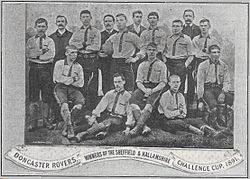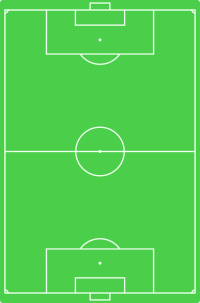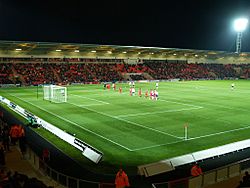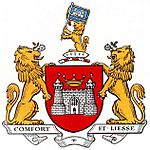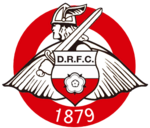Doncaster Rovers F.C. facts for kids
 |
||||
| Full name | Doncaster Rovers Football Club | |||
|---|---|---|---|---|
| Nickname(s) | Rovers | |||
| Short name | DRFC, Donny, The Red and White Army | |||
| Founded | 1879 | |||
| Ground | Eco-Power Stadium | |||
| Capacity | 15,231 | |||
| Owner | Doncaster Rovers Limited | |||
| Chairman | Terry Bramall | |||
| Manager | Grant McCann | |||
| League | League One | |||
| 2018–19 | League One, 6th of 24 | |||
|
||||
Doncaster Rovers Football Club is a professional football team from Doncaster, South Yorkshire, England. The team is often called "Rovers" or "Donny." They play their home games at the Eco-Power Stadium, which they moved to in 2007. Their home kit is red and white hoops, a design they have used since 2001.
The club started in 1879 and became professional six years later. They joined the Football League in 1901. After moving between different leagues, they won the Third Division North title in 1934–35. They won this title two more times in 1946–47 and 1949–50. Rovers also won the Fourth Division title in 1965–66 and 1968–69.
In 1998, Doncaster Rovers dropped out of the Football League. However, they quickly returned by winning the 2003 Conference play-offs. They then won the Third Division title in 2003–04. In 2007, they won the Football League Trophy. The next year, they won the League One play-offs, which brought them back to the second tier of English football for the first time since 1958. They won the League One title again in 2012–13. In the 2024–25 season, Doncaster Rovers won the 2024–25 EFL League Two title, moving up to EFL League One.
Contents
- Club History: From Start to Now
- Meet the Players
- Club Staff and Management
- Home Grounds: Where Rovers Play
- Club Badges and Symbols
- Team Kits and Sponsors
- Team Mascots
- Fan Magazine: Popular Stand
- Club Rivalries
- League Journey: Where Rovers Have Played
- Player of the Year Awards
- Club Achievements and Trophies
- Other Teams Connected to Doncaster Rovers
- See also
Club History: From Start to Now
How Doncaster Rovers Began
The club was started in 1879 by Albert Jenkins. He worked at the Great Northern Railway in Doncaster. Albert gathered his friends for a football match in September 1879. After a 4–4 draw, they decided to play more games and called themselves Doncaster Rovers.
Their first official match as Doncaster Rovers was on October 3, 1879. They became a professional club in 1885. By 1887–88, they had their first professional players. Rovers first played in the FA Cup in 1888–89.
The 1890–91 season was a big step forward. The club helped start the Midland Alliance League and finished second. The next season, they won the Sheffield and Hallamshire FA Challenge Cup. They also joined the Midland League, winning it in 1896–97 and 1898–99.
Joining the Football League
Doncaster Rovers first joined the Football League in 1901. They replaced New Brighton Tower. In their first season, they reached their highest position ever, finishing 7th in the Football League Second Division. However, they only stayed for two seasons before being voted out in 1903.
They returned to the Midland League for a season. Then, they were voted back into the Football League in 1904. But in 1904–05, they finished last with only 8 points, which is still a record. They were voted out of the league again.
Before World War I, the club faced financial problems and closed down in 1914. A new club was formed, but the war stopped all football. The army even used their ground as a depot.
The Years Between the Wars
After World War I, the club reformed in 1919. They rejoined the Midland League in 1920, playing at a temporary ground called Bennetthorpe. In 1922, they moved to Belle Vue. They finished second in the Midland League and were accepted into the Football League Division 3 North for the 1923–24 season.
Their first game back in the Football League was a 0–0 draw against Wigan Borough on August 25, 1923. One of their best players then was Tom Keetley, who scored 186 goals for the club. Doncaster Rovers became champions of Division 3 North in 1934–35. They spent two seasons in Division 2 before being relegated in 1936–37.
From World War II to the 1990s
Doncaster Rovers played in the longest ever competitive football match on March 30, 1946. It was a cup game against Stockport County that lasted 203 minutes! The game was stopped because it got too dark. Rovers won the replay 4–0.
In 1946–47, Doncaster set a record by winning 33 games in a season, becoming champions of the Third Division North. They were relegated from the Second Division the next season. But two years later, with Peter Doherty as player-manager, they won the Third Division North again. They stayed in the Second Division for eight seasons, which was their most successful time.
During this period, famous players like Harry Gregg played for Doncaster. He was sold to Manchester United in 1957 for a record fee for a goalkeeper. Another great player, Alick Jeffrey, was almost signed by Manchester United, but a bad leg injury stopped his move. Doncaster Rovers were relegated twice in a row in 1958 and 1959, falling to the Fourth Division.
Billy Bremner, a famous player for Leeds United, managed Doncaster Rovers twice.
Difficult Times and a New Start
In the early 1990s, Ken Richardson became the main owner of the club. He caused serious problems for the club, which led to its decline and his imprisonment. In 1998, Rovers were relegated out of the Football League with a very poor goal difference. Many fans blamed Richardson for the club's troubles.
A new group, the Westferry Consortium, took over the club in 1998. They promised to invest in the club. John Ryan became the chairman. He wanted to bring the club back to the second tier and build a new stadium, which he achieved within ten years. Doncaster Rovers had their best period in 50 years during the 2000s.
After five seasons in the Conference League, manager Dave Penney led the club back to the Football League in 2003. They won the 2003 Conference play-off final with a "Golden Goal." In 2003–04, their first season back, Rovers won the championship and were promoted to the third tier. They were the last team to win Division Three before it was renamed League Two.
In 2005–06, Doncaster Rovers beat two top-tier teams, Manchester City and Aston Villa, in the League Cup. They reached the quarter-finals, where they lost to Arsenal after a close game that went to penalties.
Sean O'Driscoll became the new manager in August 2006.
Recent Years: 2007 to Today
A new stadium, the Keepmoat Stadium (now Eco-Power Stadium), was finished in December 2006. Doncaster's first game there was on New Year's Day, 2007.
In the 2006–07 season, Doncaster reached the final of the Football League Trophy and won their first major trophy.

In the 2007–08 season, Doncaster reached the League One play-off final at Wembley Stadium. They beat Leeds United 1–0 to return to the second tier after 50 years. A goal from James Hayter secured the win. Doncaster stayed in the Championship for several seasons.
The 2011–12 season was tough, and manager Sean O'Driscoll was replaced by Dean Saunders. Despite bringing in some well-known players, Doncaster was relegated to League One.
For the 2012–13 season, the team was rebuilt. Brian Flynn took over as manager. In an amazing final game of the season, they beat Brentford 1–0 with a goal in the very last seconds, making them champions and earning promotion back to the Championship.
After promotion, Paul Dickov became manager. The club even signed One Direction singer Louis Tomlinson to help support a children's hospice. In May 2014, Doncaster was relegated back to League One after just one season.
Rovers were relegated to League Two in 2016. However, they earned immediate promotion back to League One in 2016–17.
Grant McCann became manager in 2018. Under him, Rovers finished sixth in League One and reached the play-offs. They lost a close semi-final to Charlton Athletic on penalties. McCann left in 2019 and was replaced by Darren Moore. Moore later moved to Sheffield Wednesday, and Andy Butler became interim manager. Doncaster finished 14th in League One.
For the 2021–22 season, former player Richie Wellens became manager, but he was later replaced by Gary McSheffrey. Doncaster finished 22nd and were relegated to League Two. They finished 18th in League Two in 2022–23.
On May 12, 2023, Grant McCann returned as manager. He led Rovers to a club record of 10 wins in a row, helping them reach the play-offs in the 2023–24 season. They lost in the semi-finals on penalties. However, McCann led Doncaster to win the League Two title in the 2024–25 season, securing their promotion.
Meet the Players
Current Squad Members
|
|
Club Staff and Management
Who Runs the Club?
| Board | |
|---|---|
| Role | Person |
| Chairman | Terry Bramall |
| Directors | Terry Bramall Gavin Baldwin |
| Chief Executive | Gavin Baldwin |
First Team Coaches
Home Grounds: Where Rovers Play
Early Home: Intake Ground (1885–1915)
For the first six years, Doncaster Rovers played wherever they could. In 1885, they found a permanent home called the Intake Ground. The club played there until 1914 when it closed down. During World War I, the army used the ground as a depot.
Temporary Home: Bennetthorpe Ground (1920–1922)
After the war, the club reformed in 1919. The army was still using the Intake Ground. So, Rovers found a temporary field called Bennetthorpe Ground. They played there for two seasons.
Long-Time Home: Belle Vue (1922–2006)
In 1922, the club moved to a new site called Low Pasture, which became known as Belle Vue. The stadium was officially opened in 1922. The first match there had 10,000 fans. Over the years, the stadium was improved with more seating and covered areas. In 1947, Belle Vue had its highest attendance of 37,099 fans.
After a stadium fire disaster in another city in 1985, some wooden stands at Belle Vue had to be removed for safety. Mining issues and new safety rules further reduced the stadium's capacity. When new owners took over in 1998, they promised a new stadium. Belle Vue was Doncaster's home for 84 years. In 2003, it was renamed the Earth Stadium due to sponsorship.
Current Home: Eco-Power Stadium (2007–Present)
A new, modern stadium with 15,231 seats was finished in December 2006. It is owned by the local council and rented by the club. The first game at the new stadium, then called Keepmoat Stadium, was on New Year's Day, 2007. The first goal scored there was by Mark McCammon. The stadium was officially opened on August 3, 2007, with a game against a Manchester United team.
In 2012, Doncaster Rovers took over the management of the stadium. On December 27, 2021, the stadium's name changed to Eco-Power Stadium due to a new sponsorship deal.
Club Badges and Symbols
Like many old English football clubs, Doncaster Rovers first used the local coat of arms as their badge. This badge showed two lions holding Yorkshire roses and a red shield with an old castle. The red and white colors of the coat of arms are why the team wears red and white. The club stopped using this badge in 1972.
In the 1960s, the Doncaster council said Rovers could no longer use the town's coat of arms. So, a competition was held to design a new badge. The winning design, still used today, was created by local students and called "the Viking."
The first Viking badge had a black and white Viking image on a red and white circle, showing the club's colors. It also included the year the club started, 1879. This Viking image became known as "The Turk's Head." The badge also had a shield with the club's initials, D.R.F.C., and the Yorkshire white rose.
In the early 1990s, the badge was changed. The red and white circle background was removed, and the Viking image was colored gold. Another change happened in 2006, with a new Yorkshire rose design and a slightly different Viking image. In 2012, the club went back to a design similar to the earlier Viking badge, which is the one they use now.
Team Kits and Sponsors
|
|
| This was the first strip worn by the club in 1879. |
|
|
| This was the first strip worn by the club when they were elected to the football league in 1901. |
From 1879 to 1885, Doncaster Rovers played in blue and white. Since then, their colors have been red and white. Their very first kit was navy blue and white with a yellow diagonal stripe. It even included a blue hat with a red pom-pom! When they first joined the Football League in 1901, their kit was a solid red shirt with a black collar. Since 2001, their main home shirt design has been red and white hoops.
Over the years, their home shirts have mostly been red and white hoops, solid red, solid white, or red and white stripes.
Recently, Rovers have had a special third kit each season to support the mental health charity Campaign Against Living Miserably (CALM). Money from some home games is donated to this charity.
| Season(s) | Shirt manufacturer | Main sponsor | Second shirt sponsor* |
|---|---|---|---|
| 1879–1977 | None | None | None |
| 1978–1979 | Umbro | ||
| 1979–1981 | Sereena | ||
| 1981–1982 | Lynx | ||
| 1982–1984 | Gertroot | ||
| 1982–1984 | Hobbott | CIL | |
| 1984–1987 | Pilkington Glass | ||
| 1987–1988 | Spall | St. George's Car Centre | |
| 1988–1990 | Doncaster Free Press | ||
| 1990–1992 | Ribero | ||
| 1992–1993 | Matchwinner | ||
| 1993–1994 | European Car Rental | ||
| 1994–1995 | Doncaster Star | ||
| 1995–1996 | Hayselden Motors | ||
| 1996–1997 | Patrick | East Riding Sacks | |
| 1997–1998 | Olympic Sports | ||
| 1998–1999 | Asics | Beazer Homes | |
| 1999–2001 | Viking Leisurewear | ||
| 2001–2002 | Vandanel | One Call Insurance | |
| 2002–2003 | Ledger Mobility | ||
| 2003–2006 | Carlotti | Streetwise Sports | Toyota |
| 2006–2007 | Streetwise Sports | Carlotti | |
| 2007–2008 | Carlotti | Wright Investments | Stoneacre Motor Group |
| 2008–2010 | Vandanel | ||
| 2010–2013 | Nike | One Call Insurance | |
| 2013–2016 | Avec | ||
| 2016–2017 | FBT | ||
| 2017–2018 | Virgin Trains East Coast | ||
| 2018–2019 | LNER | ||
| 2019–present | Elite Pro Sports |
LNER and Stoneacre have continued their sponsorship with the club.
*This sponsor appears on the back of the home kit
Team Mascots
The team's main mascot is a brown dog named Donny Dog. He wears a red and white Rovers jersey. In 2013, a second mascot appeared: a yellow-haired Viking with a helmet, named Eric the Viking. He wears the away shirt.
Fan Magazine: Popular Stand
Doncaster Rovers has a fan magazine called "Popular Stand," which started on January 17, 1998. It sells for £1, and all profits go to Doncaster Rovers or related causes. In 2016, "Popular Stand" won the Football Supporters' Federation Fanzine of the Year award.
Club Rivalries
Doncaster Rovers' main rivals are Rotherham United, Barnsley, and Scunthorpe United. They also have rivalries with other teams like Sheffield Wednesday, Sheffield United, and Leeds United.
League Journey: Where Rovers Have Played
Doncaster Rovers has played in various leagues throughout its history:
- Midland Alliance League: 1890–91
- Midland Football League: 1891–1901, 1903–04, 1905–1923
- Football League: 1901–1903, 1904–05, 1923–1998, 2003–Present
Playing in the Top Tiers
- 2nd Tier – Division 2, Championship: 1901–1903, 1904–05, 1935–1937, 1947–48, 1950–1958, 2008–2012, 2013–14
- 3rd Tier – Division 3 North, Division 3, League 1: 1923–1935, 1937–1947, 1948–1950, 1958–59, 1966–67, 1969–1971, 1981–1983, 1984–1988, 2004–2008, 2012–13, 2014–2016, 2017–2021
- 4th Tier – Division 4, Division 3: 1959–1966, 1967–1969, 1971–1981, 1983–84, 1988–1998, 2003–04, 2016–17, 2022–Present
- 5th Tier – Football Conference: 1998–2003
Recent League Performance
| Season | League | Pos | P | W | D | L | F | A | GD | Pts |
|---|---|---|---|---|---|---|---|---|---|---|
| 2022–23 | League 2 | 18th | 46 | 16 | 7 | 23 | 46 | 65 | −19 | 55 |
| 2021–22 | League 1 | 22nd | 46 | 10 | 8 | 28 | 37 | 82 | −45 | 38 |
| 2020–21 | League 1 | 14th | 46 | 19 | 7 | 20 | 63 | 67 | −4 | 64 |
| 2019–20 | League 1 | 9th | 34 | 16 | 11 | 9 | 51 | 33 | 18 | 54 |
| 2018–19 | League 1 | 6th | 46 | 20 | 13 | 13 | 76 | 58 | 18 | 73 |
| 2017–18 | League 1 | 15th | 46 | 13 | 17 | 16 | 52 | 52 | 0 | 56 |
| 2016–17 | League 2 | 3rd | 46 | 25 | 10 | 11 | 85 | 55 | 30 | 85 |
| 2015–16 | League 1 | 21st | 46 | 11 | 13 | 22 | 48 | 64 | −16 | 46 |
| 2014–15 | League 1 | 13th | 46 | 16 | 13 | 17 | 58 | 62 | −4 | 61 |
| 2013–14 | Championship | 22nd | 46 | 11 | 11 | 24 | 39 | 70 | −31 | 44 |
Pos = Position; P = Played; W = Won; D = Drawn; L = Lost; F = Goals for; A = Goals against; GD = Goal difference; Pts = Points
Player of the Year Awards
The following players have won the Doncaster Rovers Player of the Year award:
Club Achievements and Trophies
League Titles
- Third Division North / League One (Level 3)
- Champions: 1934–35, 1946–47, 1949–50, 2012–13
- Play-off winners: 2008
- Fourth Division / Third Division / League Two (Level 4)
- Champions: 1965–66, 1968–69, 2003–04, 2024–25
- Promoted: 1980–81, 2016–17
- Football Conference (Level 5)
- Play-off winners: 2003
- Midland Football League
- Champions: 1896–97, 1898–99
Cup Wins
- Football League Trophy
- Winners: 2006–07
- Conference League Cup
- Winners: 1998–99, 1999–2000
- Sheffield and Hallamshire County Cup
- Winners (7 times): 1935–36, 1937–38, 1940–41, 1955–56, 1967–68, 1975–76, 1985–86
Other Teams Connected to Doncaster Rovers
Doncaster Rovers Belles is a women's football club that started in 1969. They became part of Club Doncaster in 2019. They play in the FA Women's National League Division One Midlands.
There is also a club called Doncaster Rovers in Melbourne, Australia. They were formed in 1967 and named after the English club, but they are not officially linked.
See also
 In Spanish: Doncaster Rovers Football Club para niños
In Spanish: Doncaster Rovers Football Club para niños


